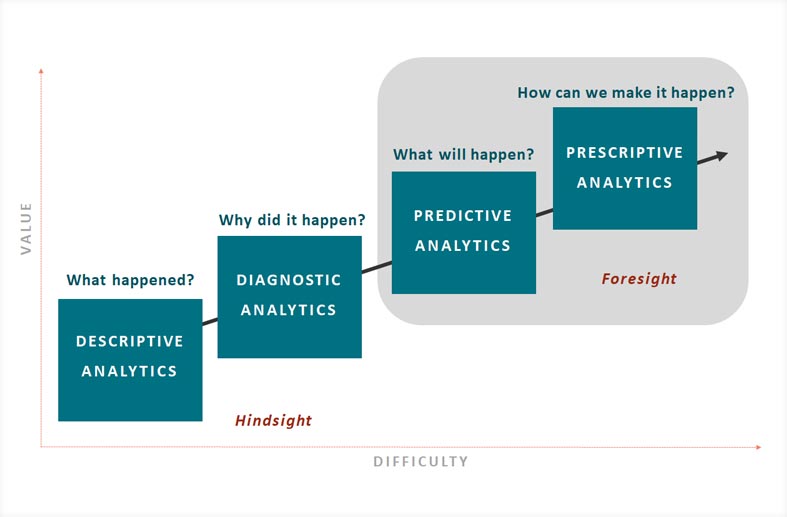The Future of Data Analytics in Higher Education is Prescriptive Analytics

Bob DiMaggio
It's 2021. And this is the year of prescriptive analytics in higher ed.
Why?
Because prescriptive analytics recommend answers to the questions, ‘What should we do?’ and ‘What can I do to meet my goals?’
The difference between predictive and prescriptive analytics
Many institutions are already using predictive analytics. Predictive analytics tell you what will happen.
That type of advanced analytics only gets colleges and universities halfway to what is needed for an institution to meet its goals and thrive.
However, what happens when the predicted outcome isn’t what you need or what you expected?
You need something that will tell you specifically how to change the outcome.
That’s how prescriptive analytics help colleges and universities.
What are prescriptive analytics?
Prescriptive analytics take predictive analytics a step further and predict the effect/consequence of future decisions and provide advice on the best course of action.
It tells you how you can change the outcome.
Why do you need prescriptive analytics for higher education?
Here's an example:
It’s April, and your enrollment office sees in its advanced analytics software that it is currently tracking below enrollment targets. During that window, your institution is immersed in the financial appeals process and hosting prospective students for virtual or campus visits.
You need to increase enrollment between now and May 1, and you have a group of admitted students who have not yet deposited.
Wouldn’t it be nice to know which action to take with each student to improve their likelihood to deposit, so you know what to do to meet your enrollment goals?
And which actions will optimize your limited resources.
Prescriptive analytics can tell you. Prescriptive analytics 'prescribe’ the best course of action to take to move the students from admits to deposits and the potential outcome of each action.
So, you know if it’s a campus visit, financial aid, meeting with a professor, or other action that will increase a student’s likelihood to enroll.
And by taking the recommended actions, you can exponentially increase the likelihood of a student enrolling at your college.
Sounds great, right?
However, because prescriptive analytics are so incredibly powerful, it is essential to invest time in learning all that it can do for you.
Five things you need to know about prescriptive analytics in higher education
1. Prescriptive analytics improve outcomes
Higher education institutions can use prescriptive analytics to understand their students better.
They offer insights to help you make informed decisions about each individual student to improve outcomes, e.g., what intervention will help George, an accounting student from Western Texas who lives 300 miles from campus and went from taking 15 credits to six and hasn’t used his meal plan in three weeks, persist to the next term.
Colleges and universities using prescriptive analytics have increased enrollment yield, optimized net tuition revenue, optimized financial aid, and improved retention or graduation rates.
By understanding what drives each student's behavior and how much, institutions can create intentional, specific plans that will positively impact students.
2. Prescriptive analytics are applicable across higher education functions
Higher education institutions can use prescriptive analytics for admissions, student success, and advancement, from the President’s office to individual recruiters and advisors, and in the boardroom, the CFO’s office, or by Institutional Research.
Meaningful applications exist in marketing, recruitment, admissions decisions, financial aid, student advising, academic planning, financial forecasting, and executive planning.
3. Prescriptive analytics’ superpower is explaining the ‘why’
Prescriptive analytics say what will happen and why it will happen and provide recommendations regarding actions that will take advantage of the predictions.
It’s data-driven advice created by simulation and optimization.
4. Prescriptive analytics offer continuous, real-time recommendations
Prescriptive analytics continually process new data as it becomes available to re-predict and re-prescribe solutions.
That means the recommendations are current and reflect what is happening with your students now.
Considering the results of prescribed actions is critical in continuing to be accurate with predictions and advice.
5. Prescriptive analytics are complex
Prescriptive analytics use sophisticated analytics tools, techniques, and technology, like artificial intelligence, machine learning, heuristics, and algorithms, making it a costly challenge to build, implement, and manage.
That’s without considering the year of data anomaly, when the pandemic disrupted enrollment cycles in March 2020, adding a level of complexity to data collection and modeling.
While some people may think that analytics aren’t useful following a year like 2020, many lessons were learned during the pandemic about how to use data and analytics for the 2021 enrollment cycle.
Does your institution have the internal resources to build a prescriptive analytics engine, or do you need to partner with a point solution? You can read the pros and cons of build versus buy here.
Prescriptive Analytics for Higher Education
Colleges and universities can use prescriptive analytics to change outcomes, support students, and meet goals.
But prescriptive analytics do not operate alone. You, the human, use the insights derived from prescriptive analytics to make decisions; It’s that balance of human and science that leads to improved outcomes.
Learn more about the value prescriptive analytics offer to your higher education institution by contacting us at othotteam@othot.com.

Bob DiMaggio



